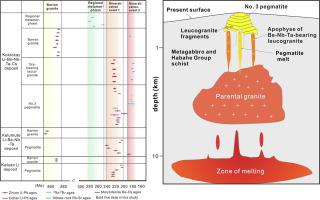Gondwana Research ( IF 7.2 ) Pub Date : 2022-09-23 , DOI: 10.1016/j.gr.2022.09.007 Ping Shen , Hong-Di Pan , Chang-Hao Li , Hao-Xuan Feng , Lan-Fang He , Ying-Xiong Bai , Yao-Qing Luo , Qing-Yu Suo , Chong Cao

|
Rare-metal granitic pegmatites are commonly associated with granites. However, for the Koktokay No. 3 pegmatite in the Chinese Altai, hosting a giant Li–Be–Nb–Ta–Cs–Rb–Hf deposit, the parental granites have not yet been found. Here we first recognized the ore-bearing leucogranites at Koktokay, in which the beryl (Be) and coltan (Nb–Ta) occur. Six coltan U–Pb ages of the leucogranites fall in a narrow range of 224.2 ± 2.7–220.7 ± 4.0 Ma which are in good agreement with our new coltan U–Pb age of 219.8 ± 1.3 Ma of the No. 3 pegmatite. Four muscovite 40Ar/39Ar ages from the same samples are from 181.1 ± 1.4 Ma to 177.2 ± 1.2 Ma which are consistent with published 40Ar/39Ar age results (182.1–179.7 Ma) from the No. 3 pegmatite. Thus, the emplacement of the leucogranites and associated mineralization occurred in late Triassic which was followed by a new mineralization at early Jurassic. The leucogranites, consisting of muscovite albite granite and minor albite granite, are characterized by high Al2O3 and Na2O and show well-developed convex tetrad effect. They are peraluminous S-type granites and were formed by highly fractional crystallization and melt-fluid interaction. The leucogranites are enriched in volatile elements (B, F, P, and H2O) and lithophile (Li, Be, Nb, Ta, Cs, and Na) with very low Zr/Hf (8.2–13.8) and Nb/Ta (0.8–5.9) ratios, indicating a fertile rock. The similar petrographic, geochemical and geochronological data between the leucogranites and the No. 3 pegmatite indicate that they are contemporaneous and cogenetic, implying a common magmatic source. A much larger, unexposed parental granite, from which the leucogranite and No.3 pegmatite have fractionated, is present at depth. A granite-pegmatite model is established that the parental granite at depth is connected with leucogranite and pegmatite at shallow which is likely responsible for the formation of the giant Koktokay No. 3 pegmatite.











































 京公网安备 11010802027423号
京公网安备 11010802027423号